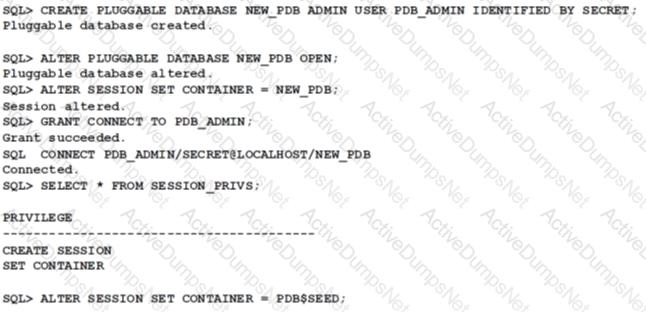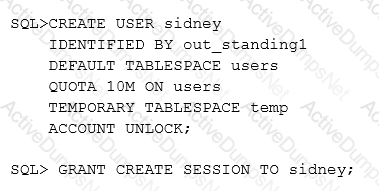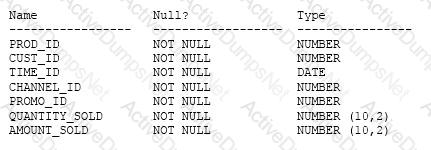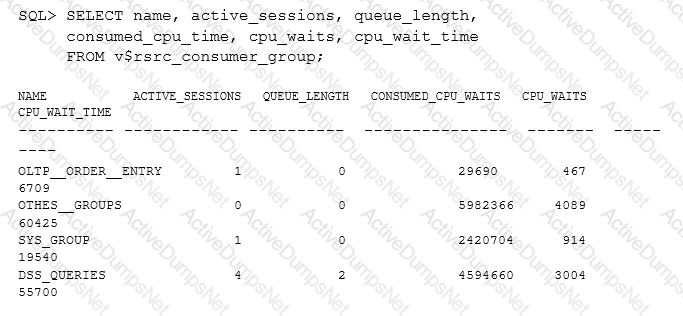Which three statements are true about naming methods? (Choose three.)
Which statement is true about using the Database Upgrade Assistant (DBUA) to upgrade your database from Oracle Database 11g to Oracle Database 12c?
Which statement is true about profiles?
As part of a manual upgrade of your database to Oracle Database 12c, you plan to issue the command:
SQL> STARTUP UPGRADE
Which three statements are true about the upgrade process? (Choose three.)
You are using RMAN to back up your database. All the data files are in read/write mode.
Examine the RMAN configuration parameters:

Which two statements are true about a whole consistent backup of a database running in ARCHIVELOG mode? (Choose two.)
Which three statements are true about Oracle Data Pump? (Choose three.)
Which three statements are true about checkpointing? (Choose three.)
Which three statements are true about Automatic Workload Repository (AWR)? (Choose three.)
Which two can be recommendations given by SQL Access Advisor? (Choose two.)
What is the effect of setting the STATISTICS_LEVEL initialization parameter to BASIC?
Which statement is true regarding the DEFAULT profile?
Which three statements are true about Database Resource Manager? (Choose three.)
Your database is running in ARCHIVELOG mode.
You want to take a consistent whole database backup.
Which two statements are true in this scenario? (Choose two.)
Your database is configured for ARCHIVELOG mode, and a daily full database backup is taken. RMAN is configured to perform control file autobackup.
In which three scenarios do you need media recovery? (Choose three.)
When is the UNDO_RETENTION parameter value ignored by a transaction?
You install Oracle Grid Infrastructure for a standalone server.
Which two components are automatically included in the Oracle Restart configuration? (Choose two.)
Which two statements are true about Oracle network connections? (Choose two.)
You want to create a test database as a replica of your production database with minimum intervention from a DBA.
Which method would you use?
Which three tools or tasks are run by default as part automated maintenance tasks? (Choose three.)
Which three statements are true about Flashback Database? (Choose three.)
Examine the parameters for your database instance:

Which three statements are true about the process of automatic optimization by using cardinality feedback? (Choose three.)
You are connected using SQL* Plus to a multitenant container database (CDB) with SYSDBA privileges and execute the following sequence statements:

What is the result of the last SET CONTAINER statement and why is it so?
A database instance is started by using an SPFILE. The database is configured in ARCHIVELOG mode and the control file autobackup is configured. Daily full database backups are performed by using RMAN.
You lost all control files due to media failure.
Given the steps to recover from the error in random order:
1. Shut down the instance, if it is not already down.
2. Restore the control file from autobackup to a new location.
3. Start the database instance to NOMOUNT state.
4. Recover the database to the point of failure of the control file.
5. Open the database with the RESETLOGS option.
6. Mount the database.
7. Update the SPFILE with the new location of the control file by using the ALTER SYSTEM command.
Identify the correct sequence of the required steps.
In your production database, data manipulation language (DML) operations are executed on the SALES table.
You have noticed some dubious values in the SALES table during the last few days. You are able to track users, actions taken, and the time of the action for this particular period but the changes in data are not tracked. You decide to keep track of both the old data and new data in the table long with the user information.
What action would you take to achieve this task?
You execute this command:

Which two statements are true about segment space management for segments in this tablespace? (Choose two.)
Examine the commands executed to monitor database operations:
$> conn sys oracle/oracle@prod as sysdba
SQL > VAR eid NUMBER
SQL > EXEC: eid := DBMS_SQL_MONITOR.BEGIN_OPERATION (‘batch_job’ , FORCED_TRACKING => ‘Y’);
Which two statements are true? (Choose two.)
Your multitenant container (CDB) containing three pluggable databases (PDBs) is running in ARCHIVELOG mode. You find that the SYSAUX tablespace is corrupted in the root container.
The steps to recover the tablespace are as follows:
1. Mount the CDB.
2. Close all the PDBs.
3. Open the database.
4. Apply the archive redo logs.
5. Restore the data file.
6. Take the SYSAUX tablespace offline.
7. Place the SYSAUX tablespace online.
8. Open all the PDBs with RESETLOGS.
9. Open the database with RESETLOGS.
10. Execute the command SHUTDOWN ABORT.
Which option identifies the correct sequence to recover the SYSAUX tablespace?
Your database instance has started using an SPFILE.
Examine the RMAN configuration settings:

You execute the command:
RMAN> BACKUP AS COPY TABLESPACE TEST;
Which three types of files are backed up by using this command? (Choose three.)
Which three statements are true about space usage alerts? (Choose three.)
Which statement is true about Enterprise Manager (EM) express in Oracle Database 12c?
Which three statements are true about the Pre-Upgrade Information Tool? (Choose three.)
A database is stored in an Automatic Storage Management (ASM) disk group, disk group, DGROUP1 with SQL:

There is enough free space in the disk group for mirroring to be done.
What happens if the CONTROLLER1 failure group becomes unavailable due to error of for maintenance?
Examine the following command;
ALTER SYSTEM SET enable_ddl_logging = TRUE;
Which statement is true?
Examine these two statements:

Which three are true about the MRKT tablespace? (Choose three.)
You executed the following command to create a password file in the database server:
$ orapwd file = orapworcl entries = 5 ignorecase=N
Which statement describes the purpose of the above password file?
Your database is configured in ARCHIVELOG mode.
Examine the RMAN configuration parameters:

Examine the command:
RMAN> BACKUP DATABASE PLUS ARCHIVELOG DELETE INPUT;
What is the outcome?
The persistent configuration settings for RMAN have default for all parameters.
Identify four RMAN commands that produce a multi-section backup.
Examine the parameters for a database instance:

Your database has three undo tablespaces and the default undo tablespace is not autoextensible.
Resumable space allocation is not enabled for any sessions in the database instance.
What is the effect on new transactions when all undo space in the default undo tablespace is in use by active transactions?
Which two statements are true concerning the Resource Manager plans for individual pluggable databases (PDB plans) in a multitenant container database (CDB)? (Choose two.)
Which three statements are true PFILEs, SPFILEs or both? (Choose three.)
Which three statements are true about a job chain? (Choose three.)
Your database is in ARCHIVELOG mode.
You want to disable archiving for the database.
Examine these steps:
1. Execute the ALTER DATABASE NOARCHIVELOG command
2. Execute SHUTDOWN IMMEDIATE
3. Execute STARTUP MOUNT
4. Set the DB_RECOVERY_FILE_DEST parameter to $ORACLE_HOME/dbs/
5. Execute STARTUP NOMOUNT
6. Open the database
7. Execute SHUTDOWN TRANSACTIONAL
Identify the required steps in the correct sequence.
You execute the commands:

Which two statements are true? (Choose two.)
As a user of the ORCL database, you establish a database link to the remote HQ database such that all users in the ORCL database may access tables only from the SCOTT schema in the HQ database. SCOTT’s password is TIGER. The service mane “HQ” is used to connect to the remote HQ database.
Which command would you execute to create the database link?
Which two statements are true about Oracle Managed Files (OMF)? (Choose two.)
Examine the current value for the following parameters in your database instance:
SGA_MAX_SIZE = 1024M
SGA_TARGET = 700M
DB_8K_CACHE_SIZE = 124M
LOG_BUFFER = 200M
You issue the following command to increase the value of DB_8K_CACHE_SIZE:
SQL> ALTER SYSTEM SET DB_8K_CACHE_SIZE=140M;
Which statement is true?
Which two statements are true about the RMAN validate database command? (Choose two.)
You notice that the elapsed time for an important database scheduler Job is unacceptably long.
The job belongs to a scheduler job class and window.
Which two actions would reduce the job's elapsed time? (Choose two.)
What is the effect of specifying the "ENABLE PLUGGABLE DATABASE" clause in a "CREATE DATABASE” statement?
Examine the structure of the SALES table, which is stored in a locally managed tablespace with Automatic Segment Space Management (ASSM) enabled.

You want to perform online segment shrink to reclaim fragmented free space below the high water mark.
What should you ensure before the start of the operation?
Which three statements are true concerning unplugging a pluggable database (PDB)? (Choose three.)
Examine the resources consumed by a database instance whose current Resource Manager plan is displayed.

Which two statements are true? (Choose two.)
You wish to enable an audit policy for all database users, except SYS, SYSTEM, and SCOTT.
You issue the following statements:
SQL> AUDIT POLICY ORA_DATABASE_PARAMETER EXCEPT SYS;
SQL> AUDIT POLICY ORA_DATABASE_PARAMETER EXCEPT SYSTEM;
SQL> AUDIT POLICY ORA_DATABASE_PARAMETER EXCEPT SCOTT;
For which database users is the audit policy now active?
You are about to plug a multi-terabyte non-CDB into an existing multitenant container database (CDB).
The characteristics of the non-CDB are as follows:
– Version: Oracle Database 11g Release 2 (11.2.0.2.0) 64-bit
– Character set: AL32UTF8
– National character set: AL16UTF16
– O/S: Oracle Linux 6 64-bit
The characteristics of the CDB are as follows:
– Version: Oracle Database 12c Release 1 64-bit
– Character Set: AL32UTF8
– National character set: AL16UTF16
– O/S: Oracle Linux 6 64-bit
Which technique should you use to minimize down time while plugging this non-CDB into the CDB?
You upgrade your Oracle database in a multiprocessor environment. As a recommended you execute the following script:
SQL > @utlrp.sql
Which two actions does the script perform? (Choose two.)
An administrator account is granted the CREATE SESSION and SET CONTAINER system privileges.
A multitenant container database (CDB) instant has the following parameter set:
THREADED_EXECUTION = FALSE
Which four statements are true about this administrator establishing connections to root in a CDB that has been opened in read only mode? (Choose four.)